Cape May
Cape May is the southernmost city in New Jersey, sitting on the tip of the peninsula that divides Delaware Bay from the Atlantic Ocean. The peninsula was first charted by Dutch Captain Cornelius Jacobsen May (or Mey) who explored the area in the early 1620s. The settlement bearing his name was established in 1630s by whalers and fishermen who purchased the land from the local Indians. From the mid 18th century Cape May began to develop as a seaside resort, soon becoming a favourite destination for Philadelphians. By the mid 19th century Cape May was bringing in visitors from further afield and work started to build the 3,500 room Mount Vernon Hotel, the largest hotel in the world. Unfortunately the hotel was destroyed by fire in 1856 while still under construction. In 1878 a fire that lasted for five days destroyed 14 hectares (35 acres) of the city. After the fire Cape May was rebuilt on a more modest scale with buildings typical of the time. The birth and growth of Atlantic City, plus the devastating fires in Cape May, resulted in a decline in its popularity as a resort. The decline has left Cape May with a tremendous legacy of Victorian architecture. So fine and well maintained are the Victorian buildings that in 1976 the entire city was designated a National Historic Landmark.
Typical Cape May Victorian houses
Walking around Cape May you could imagine that you are in an open air museum rather than a working city. These multicoloured Victorian houses with turrets, towers and balconies are typical of Cape May.
Joseph Hall Cottage, Hughes Street
This Carpenter Gothic house was built in 1868 for Joseph Hall. a contractor and builder of West Cape May. Like many of the houses in Cape May it remains a private home.
Home > US States > Midatlantic USA > New Jersey >
Click on Minimap to navigate
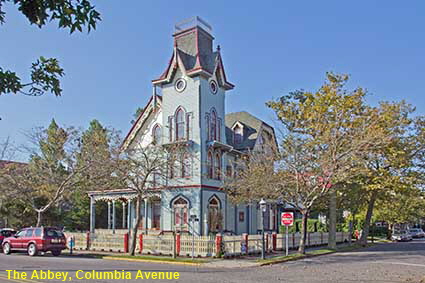
The Abbey, Columbia Avenue
The Abbey is a typical Victorian Cape May house. This Gothic Revival Villa was built in 1869 for Philadelphia Coal Baron John McCreary. Like many of the more flamboyant old houses in Cape May it became a Bed and Breakfast Inn, but in more recent times it has become a Vacation Rental Home.
Chalfonte Hotel, Howard Street
One building that survived the 1878 fire was the Chalfonte Hotel. It was built in 1876 by Henry Sawyer, who had been a Colonel in the Union Army during the Civil War. The hotel originally had 18 rooms but after the 1878 fire it was extended to 37 rooms. A further 23 rooms were added around the turn of the century, and by 1909 it looked much as it does now. The Chalfonte Hotel is now the oldest continuously operating hotel in Cape May. This picture has been modified to remove some of the unsightly wires that pass the front of the building.
DLU171411


To move forwards or backwards through the New Jersey trail click the arrows above, or select your next destination on the Minimap.
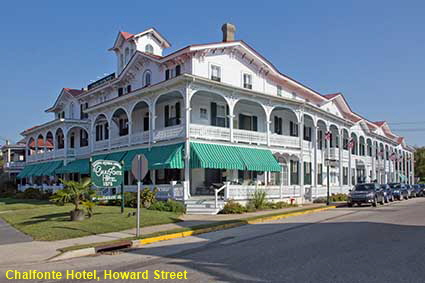
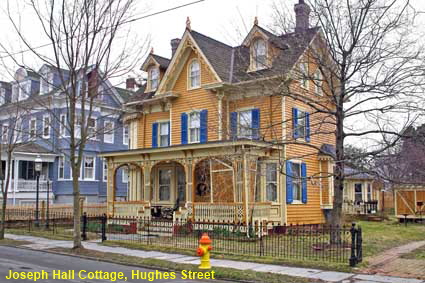
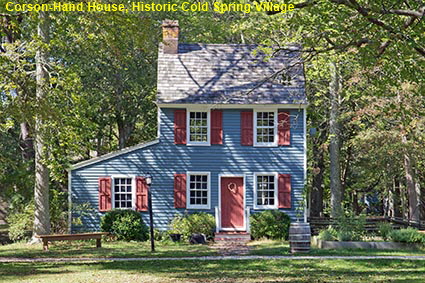
Corson-Hand House, Historic Cold Spring Village
In case you can’t find enough historic buildings in Cape May itself, just 6 km (4 miles) north is Historic Cold Spring Village, a collection of 25 restored historic buildings complete with interpreters in 1850s period clothing. The Corson-Hand House dates back to 1837 when it was built in Tuckahoe, New Jersey. This asymmetrical design was common in Cape May County from the early 1700s to the 1850s but is rarely found in other parts of New Jersey. The house was built by Aaron Corson, a ship’s carpenter who in 1839 sold it to shoemaker Philip Hand. The house is now used to demonstrate spinning, weaving, and wool carding techniques from the era. Click Tab 2 to see the J Hathorn House, part of which dates back to 1722. It is now the Cold Spring Village Country Store.
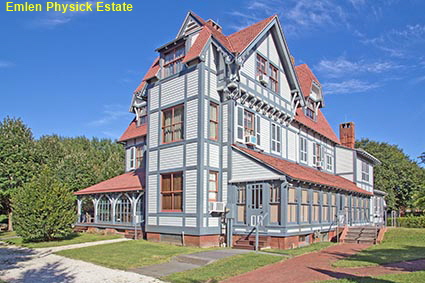
Emlen Physick Estate
Back in Cape May itself, this 18 room mansion was built in 1879 for Dr. Emlen Physick Jr. his widowed mother and his Maiden Aunt Emilie. It was designed by Philadelphia architect Frank Heyling Furness. The mansion was designed in the Stick Style named after the raised boards (sticks) overlaid on the clapboard walls. Emlen Physick Jr never married, and although he had graduated from medical school he did not practice as a medical Doctor. Instead he was a gentleman farmer and real estate trader. In the 1970s the estate was threatened with demolition so the Mid-Atlantic Center for the Arts & Humanities (MAC) was formed to save it. The City of Cape May purchased the Emlen Physick Estate then MAC restored the mansion and they have opened it to the public as a Victorian House Museum. Click Tab 2 to see the Carriage House, now used as the Ticket Office.
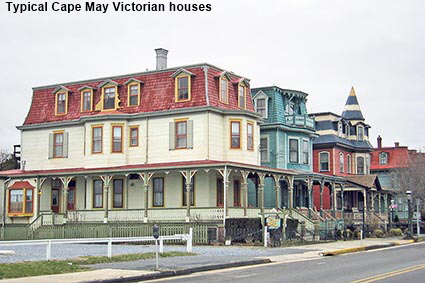
Dr Henry Hunt House, Congress Place
Finally, let us finish with a glorious example of well preserved Victorian excess. This house was built for Dr. Henry Hunt in 1881 on the site of the Congress Hall Hotel which was destroyed in the 1878 fire. The original design was simpler but in the 1890s the house was renovated; plumbing was installed and ornamentation added. Complete with its gabled turret and octagonal belvedere it has to be one of the most over the top Victorian houses in Cape May.
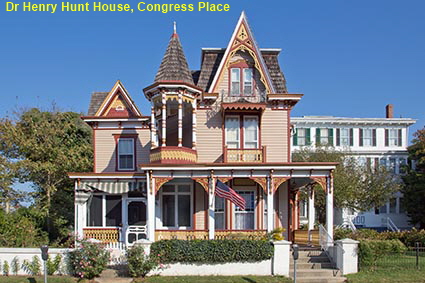
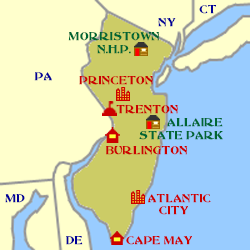
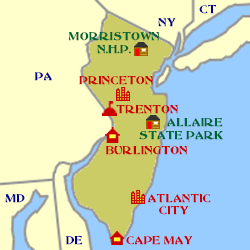
© Mike Elsden 1981 - 2025
The contents of this page may not be reproduced in full or in part without permission